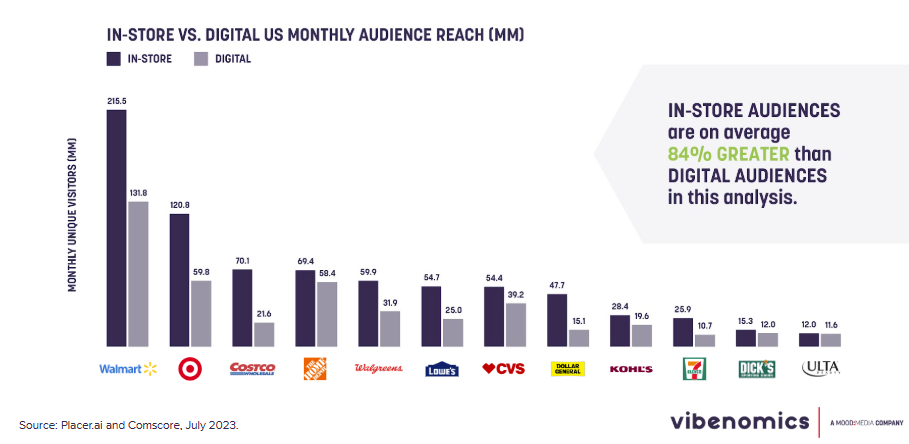
Even in an era of digital convenience, in-store remains a critical touchpoint for brands. According to Vibenomics’ 2025 In-Store Advertising Report, consumer behavior isn’t one-size-fits-all; it’s deeply influenced by generation.
For brands and agencies, understanding the nuances of how different age groups shop in-store is the key to unlocking more effective advertising, driving sales, and building lasting loyalty right at the point of purchase. This report provides a roadmap to connecting with every shopper, from Gen Z to Baby Boomers.
Generational Snapshot
A striking takeaway from the report is that every generation continues to shop in-store, they just do it for different reasons and with different expectations.
The universal truth is that the in-store environment is thriving. The opportunity lies in tailoring the in-store experience to each group’s unique mindset.
Shared Shopping Behaviors: The Common Ground
Despite their differences, generations share common ground that makes in-store media a powerful tool across the board.
In-Store Visit Frequency
All generations are frequent visitors to essential retailers like grocery stores (over 94% for all groups), drugstores, and dollar/discount stores. This creates a consistent, high-traffic environment for advertising.
Responsiveness to In-Store Discovery
Browse leads to buying. A significant majority of Millennials (74%), Gen X (87%), and even Baby Boomers (82%) report discovering new products while shopping in-store.
Sensory Impact
The combination of sight and sound has a proven impact. In-store audio is seen as informative by majorities across generations, and when combined with visual cues, it creates a memorable brand moment.
Differences by Generation
Here’s where a segmented strategy becomes crucial. Each generation navigates the store with a distinct mission and mindset.
Gen Z: Tech-Driven, Music-Influenced, Fast Decision-Makers
Drawn by immediacy (63%), Gen Z wants to get what they need and go. However, they are also open to discovery and highly influenced by the store’s atmosphere. A remarkable 1 in 2 Gen Z shoppers has purchased a product after hearing an in-store audio ad, making them the most responsive generation to audio.
Millennials: Convenience-Focused, Experience-Driven
This group shops in-store to physically interact with products (60%). They are explorers who value convenience and brand alignment. With 74% discovering new items while browsing in-store and 37% influenced by audio and display ads, they are primed for messages that tell a product story and enhance their experience.
Gen X: Deal-Seeking, Brand-Loyal Mission Shoppers
Gen X values efficiency (74% cite immediacy as their top reason to shop in-store) but remains highly open to discovering new products in-store (87%). They are loyal to store types like discount and grocery retailers, suggesting they appreciate value. They respond to clear, informative messaging that respects their time and intelligence.
Baby Boomers: Clarity-Focused, Less Impulsive
Boomers are purposeful, habitual shoppers, with 53% stating they repeatedly purchase the same products. They prioritize familiarity and trust. While less influenced by digital display, over half view in-store audio ads as informative, showing an openness to helpful, non-intrusive information that reinforces brand reliability or highlights practical value.
In-Store Audio Ad Opportunities
For a CPG brand or agency, this data provides a clear playbook for tailoring audio creative to maximize resonance to every generation.
Gen Z
Use energetic, upbeat audio with modern music to grab their attention. Messages should be quick, dynamic, and highlight instant benefits or entertainment value.
Example: A TikTok-viral makeup brand leverages its social proof with an in-store audio ad voiced by a top Gen Z influencer. The ad uses a fast-paced, authentic voiceover to quickly highlight the new product’s convenience and key benefits, creating a sense of FOMO (fear of missing out) and driving immediate purchase.
Millennials
Focus on brand-aligned information and storytelling. Use a confident, authentic tone to explain product benefits, sourcing, or values that connect with their lifestyle.
Example: An established coffee brand introduces its new dairy-free cold brew via an in-store audio ad. The ad features a calm, knowledgeable female voice, creating a sense of a trusted recommendation. The creative quickly communicates the product’s convenient, healthy benefits and directs shoppers to the refrigerated aisle, positioning it as the perfect solution for their busy, wellness-oriented lifestyle.
Gen X & Boomers
Deliver clear, simple, and value-oriented messages. A calm, authoritative voice that highlights promotions, quality, and reliability will build trust and encourage a purchase.
Example: A leading salad brand leverages its 50-year heritage in an in-store audio ad promoting a limited-time BOGO offer. The ad features a confident, trustworthy male voice that cuts through the noise with a clear value proposition. The creative focuses on the immediate savings and trusted quality, compelling shoppers to take advantage of the deal before it’s gone.
Conclusion
In today’s retail landscape, a one-size-fits-all advertising strategy is no longer sufficient. To truly connect with consumers, brands and agencies must move beyond simply being seen and instead focus on being heard, noticed, and remembered.
By strategically combining audio and display—such as energetic sound to draw Gen Z to an interactive screen or clear, value-driven audio to reinforce a promotion for Boomers—brands can create a powerful sensory synergy. The key is to continuously test, learn, and refine using real-time shopper data, transforming a routine shopping trip into a powerful and resonant brand interaction for every generation.
Getting Started with Vibenomics
Vibenomics is a leading in-store advertising provider, reaching over 170 million unique shoppers and 1 billion shopping visits monthly. Our platform enables brands to deliver impactful audio, display, and experiential ads to engage consumers in real time.
Ready to elevate your retail media strategy with in-store audio? Click here to engage with Vibenomics today.
Source: Vibenomics 2025 In-Store Advertising Report: Generational Shopping Behaviors, July 2025, n=973
Introduction: A New Channel for Scale
Non-endemic advertising refers to brands promoting offerings not sold in the store where the ad appears. Think of wireless carriers, streaming platforms, health and wellness services, or financial products being advertised in a grocery store.
Traditionally, these brands leaned on TV, radio, billboards, and digital to build awareness. But those channels are increasingly cluttered, expensive, and fragmented. Now, a growing number of advertisers, including CPG marketers, are turning to in-store audio and display to break through.
In-store advertising isn’t just shelf-level signage anymore: it’s a national-scale awareness channel hiding in plain sight. For example, Vibenomics operates an in-store audio network that reaches 170 million unique shoppers every month, more than any single broadcast network. That’s over twice the monthly audience of the Super Bowl!

Why In-Store Media Works, Even for Non-Endemic Brands
Retail environments are full of high-intent, focused consumers. Shoppers are present, purposeful, and open to influence. It’s this attention-rich atmosphere that makes in-store media effective, even when promoting brands not sold in-store.
In a recent Vibenomics x Suzy study:
And consumers are surprisingly open to a diverse mix of categories being advertised while they shop:
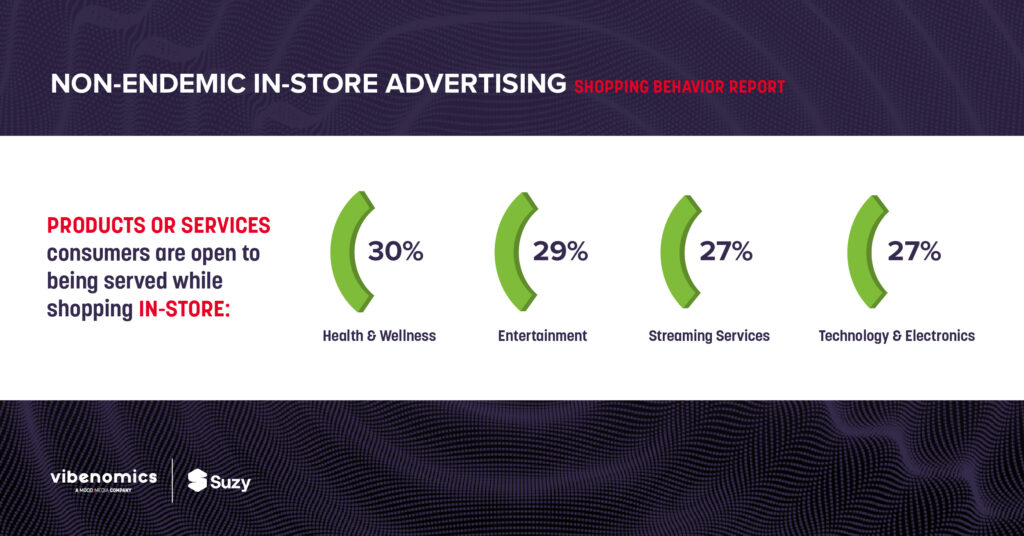
This suggests a halo effect for non-endemic brands and a cross-category opportunity for endemic brands to align with relevant adjacencies.
Audio Advertising: Passive, Yet Powerful
One of the biggest strengths of in-store audio is that it doesn’t require direct attention. It reaches consumers seamlessly as they shop, during those critical decision-making moments.
But passive doesn’t mean forgettable. Quite the opposite. Shoppers say the following characteristics grab their attention most in an in-store ad:
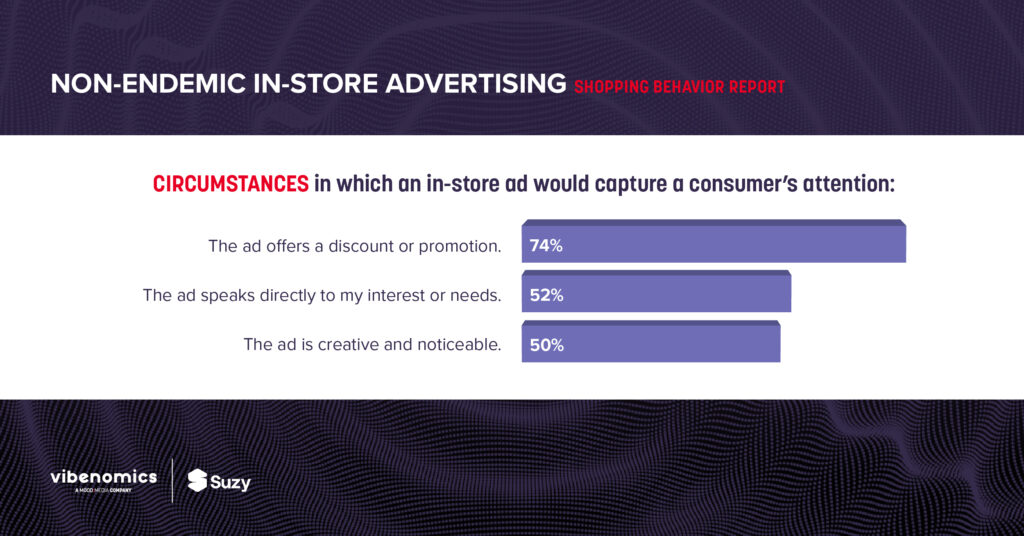
These findings reflect what marketers already know: the right message, in the right moment, works, even if the product or service isn’t in the store.
Example: A leading streaming platform ran an in-store audio campaign, targeting weekend grocery shoppers with a call to action to sign up for a free month-long trial. The ad’s creative mentioned a promotion, which caught the consumers’ attention, influencing them to try out the streaming platform when they got home from the store.
Display Advertising: Visual Reinforcement That Amplifies Impact
While in-store audio is powerful on its own, adding digital displays multiplies the effect. Visually engaging screens placed at key touchpoints serve as high-impact reminders, reinforcing audio messaging at eye level. When combined, the result is a multi-sensory experience that sticks with shoppers.
Example: A top nationwide health and wellness gym utilized in-store audio to promote a new workout app they created. The ad creative consisted of hype music and an inviting voice persuading shoppers to download the app, while digital displays showed a glimpse into the workout app with a fitness instructor doing burpees. This caught the consumers’ attention, influencing them to try out the workout app when they got home from the store.
The Takeaway
In-store media is no longer just for CPG brands. For non-endemic advertisers, it’s a scalable, data-backed way to drive brand awareness, lift, and ROI, right where shoppers are most focused.
By combining in-store audio and display, brands, endemic and non-endemic alike, can break through the noise of traditional media and connect with consumers in a real-world setting that inspires trust and attention.
Ready to turn aisles into awareness? The opportunity is already in-store.
Getting Started With Vibenomics
Vibenomics is a leading in-store advertising provider, reaching over 170 million unique shoppers and 1 billion shopping visits monthly. Our platform enables brands to deliver impactful audio, display, and experiential ads to engage consumers in real time.
Ready to elevate your retail media strategy with in-store audio? Click here to engage with Vibenomics today.
Source: Vibenomics Non-Endemic Brand In-Store Advertising Shopping Behaviors, June 2025 n=1,000
You’ve nailed your social media strategy, partnered with the perfect influencers, and your online buzz is building. But what happens when those eager customers walk into a physical store? Are you maximizing your impact at the crucial point of purchase? The answer might lie in a powerful, often overlooked synergy: the fusion of your social strategy with impactful in-store advertising.
Recent data from Vibenomics Social & Influencer Marketing Shopping Behaviors Report illuminates the incredible potential of this connection, especially when it comes to influencer marketing. Let’s dive into the numbers and see how you can supercharge your in-store sales.
1. The Power of Influencer Recommendations In-Store
Think about this: 85% of consumers indicated their purchase of a specific product in-store was due to an influencer’s review or recommendation. That’s a massive pull! Your influencer campaigns are driving desire, but are you capitalizing on that desire at the shelf?
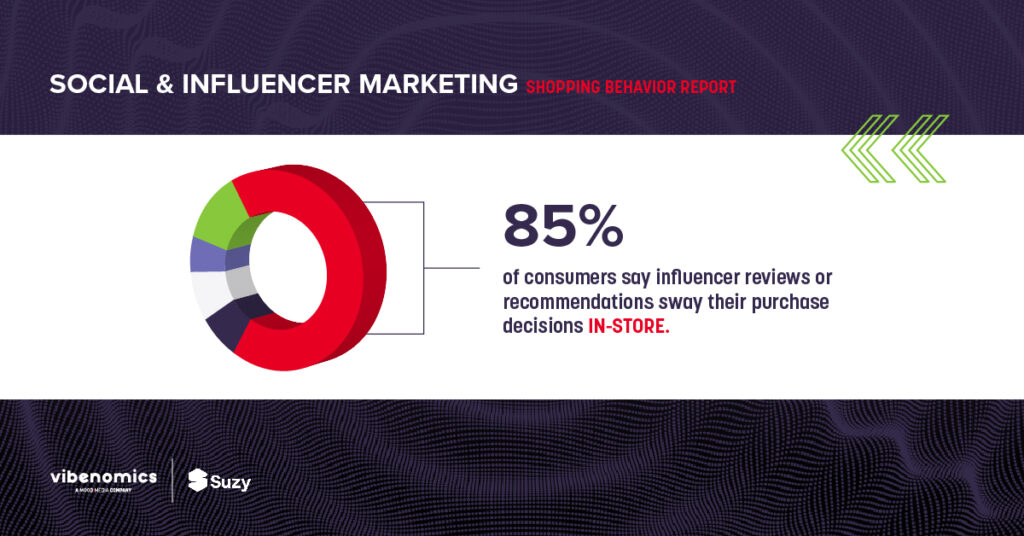
In-Store Advantage: Imagine a shopper browsing the beverage aisle. Suddenly, an overhead audio ad plays a snippet of their favorite fitness influencer raving about the crisp, refreshing taste of a particular energy drink. This audio reinforces the influencer’s positive review they saw online, making the purchase decision feel like a natural next step. Complement this with a vibrant display featuring the influencer’s image and a QR code linking to their full review, and watch those carts fill up!
2. Aligning In-Store with Influencer Strengths
The same report revealed the top-ranked factors for consumers making a purchase decision based on an influencer’s review or recommendation:
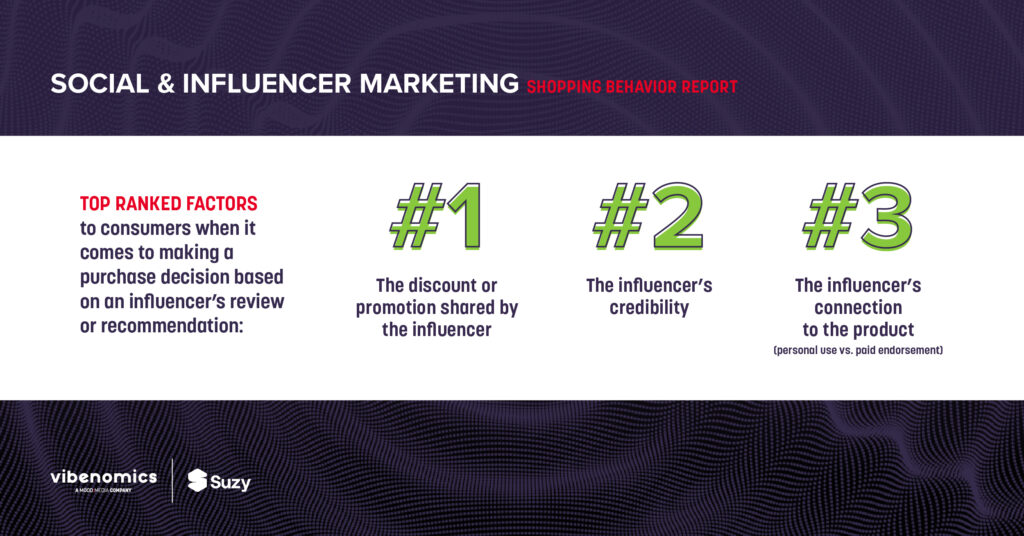
In-Store Advantage: In-store advertising is the perfect platform to amplify these key drivers. Let’s say a beauty influencer, known for their authentic and honest reviews, partners with a woman-owned skincare brand. An in-store audio ad can clearly announce the exclusive discount code the influencer shared with their followers, reminding shoppers to take advantage of the offer right then and there, as well as the importance of supporting a woman-owned beauty company. Simultaneously, strategically placed shelf talkers can feature a quote from skincare brand’s founder, bolstering their credibility at the moment of consideration. Eye-catching displays can even showcase the influencer using the product, visually reinforcing their connection.
3. A Tangible Touchpoint for Social Buzz
The data speaks volumes: 87% of consumers said that In-Store Ads (overhead audio, displays, etc.) have the biggest impact on consumers’ in-store purchase decisions, and a remarkable 81% said Influencer Promotions or Recommendations have the biggest impact. This isn’t an either/or scenario; it’s a powerful “and.”
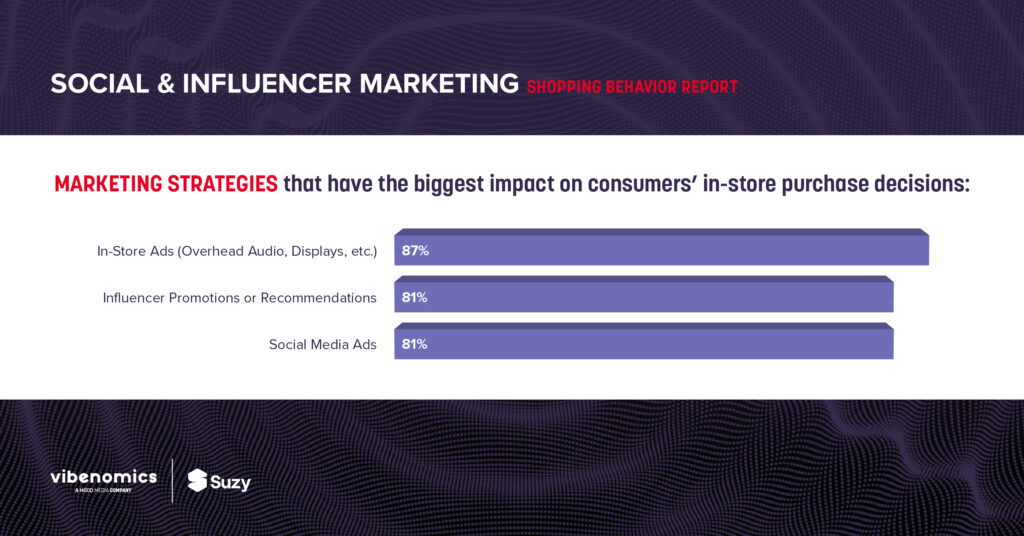
In-Store Advantage: In-store audio can act as the ultimate call to action for your influencer campaigns. Imagine an audio ad that not only highlights an influencer’s favorite features of their go-to snack product, but also directs shoppers to a specific aisle and shelf location in the store. This audio guidance transforms online interest into tangible in-store action. Paired with digital displays showcasing influencer-created content or user-generated content inspired by the influencer, you create a seamless and compelling journey from social feed to shopping cart.
Final Thoughts
Don’t let your brilliant social and influencer marketing efforts stop at the store entrance. By strategically integrating engaging in-store advertising, particularly the persuasive power of audio, you can amplify your influencer’s message, connect with consumers at the critical point of purchase, and ultimately, supercharge your social strategy. It’s time to bridge the digital and physical worlds and unlock the full potential of your multi-channel campaigns.
Getting Started with Vibenomics
Vibenomics is a leading in-store advertising provider, reaching over 170 million unique shoppers and 1 billion shopping visits monthly. Our platform enables brands to deliver impactful audio, display, and experiential ads to engage consumers in real time.
Ready to elevate your retail media strategy with in-store audio? Click here to engage with Vibenomics today!
Source: Vibenomics Social & Influencer Marketing Shopping Behaviors Report, Suzy Market Research, May 2025 n=1,160

Vibenomics conducted a comprehensive survey in collaboration with Suzy Market Research to better understand what motivates consumers along their shopping journeys. The survey gathered insights from 539 shoppers aged 18 to 99, all serving as primary or shared shoppers in their household.
There are various factors impacting where consumers fall on the product adoption curve. These participants provided valuable perspectives on their evolving behaviors and the role in-store advertising plays in their product adoption. The findings offer a detailed look into what drives consumer action and how in-store advertising influences their purchase decisions—insights brands can use to optimize their strategies for product adoption
What is Product Adoption?
Product adoption refers to how consumers integrate a new product into their lives. Rather than being a fixed process, it can be better understood as a framework represented by the Product Adoption Curve. This curve illustrates how different segments of consumers adopt a product over time—ranging from innovators and early adopters to the early majority, late majority, and laggards. Each group is motivated by different factors and adopts at varying stages of the product’s lifecycle.
Understanding where consumers fall on this curve helps brands shape strategies that meet users where they are in their adoption journey. A brand’s ability to engage consumers across the segments mentioned above plays a significant role in determining whether a product succeeds or fails in the market.
Consumer Behavior: Early Adoptors vs. Late Majority
When it comes to adopting new products, consumers vary widely in how quickly they’re willing to try something new:
How Brands Can Leverage In-Store Advertising to Drive Earlier Product Adoption:
Brands can target the 37% of consumers who like to try products after reading reviews by creating a sense of urgency and trust through in-store audio and display. For instance, a brand could advertise a product via digital displays and audio ads at the same time, highlighting positive testimonials on the advertised product’s quality or taste,effectively persuading shoppers in-store.
A great example of this would be a beauty brand promoting a new mascara product. A lit-up end cap display can showcase the mascara. At the same time, an in-store audio ad highlights the product’s technology—emphasizing how it lasts all day and encouraging consumers to test it out themselves, which helps move the consumer through the trial phase of product adoption.
What Motivates Consumers to Try New Products
Several key factors drive consumer interest in trying unfamiliar products or brands:
How Brands Can Leverage In-Store Advertising to Motivate Consumers:
For the 66% motivated by recommendations and 59% by positive reviews, brands can capitalize on in-store audio and displays to amplify word-of-mouth marketing, thus supporting the interest and evaluation stages of adoption. A brand can use audio messages featuring influencer endorsements or highlight product features like quality or taste.
For example, a leading French multinational food company used Vibenomics to promote its vanilla almond milk product. The in-store audio campaign strategically compared vanilla almond milk to traditional dairy options by highlighting a national taste test where 7 out of 10 dairy drinkers preferred almond milk. The audio campaign also encouraged shoppers to visit the dairy aisle and try the product for themselves, boosting both the trial and evaluation stages of adoption.
How Much Research Consumers Conduct Before Purchasing
Consumers differ in how much effort they put into researching a product before making a purchase decision:
How Brands Can Leverage In-Store Advertising to Educate Shoppers
For the 58% who conduct moderate research, brands can enhance the in-store experience by providing real-time access to reviews, ratings, and product information through in-store displays and audio. Imagine a store where a shopper can hear about a product’s unique features through an in-store audio campaign while viewing ratings on an interactive display simultaneously—helping them quickly move from consideration to trial and adoption.
Likelihood to Deviate from Favorite Brands Across Categories
Brand loyalty can shift depending on the product category, with consumers more likely to try new brands in some areas than others:
How Brands Can Leverage In-Store Advertising to Encourage Brand Adoption:
The fact that so many consumers are open to switching brands presents an opportunity for in-store advertising to drive trial and increase adoption. Consider this example:
During flu season, a shopper browsing the health and wellness aisle hears an audio ad highlighting a new immunity-boosting supplement. At the same time, a nearby display showcases the product’s unique health benefits and limited-time offers. This multi-sensory experience captures attention, builds trust, and nudges trial—especially effective in high-switch categories like food, beverages, and personal care.
Influence of Advertising on Purchase Decisions
Different forms of advertising play varying roles in shaping consumer behaviors in-store:
How Brands Can Leverage In-Store Advertising to Influence Purchase Decisions:
With 59% of shoppers influenced by in-store ads, using audio and display advertising is a direct way to engage customers at the point of purchase. For instance, a CPG brand could run an in-store audio campaign to promote a limited-time discount on specific cleaning products for spring cleaning. In contrast, an in-store digital display could showcase the promoted product’s look and special pricing. This combination of advertising elements supports product adoption’s evaluation and purchase stages.
Conclusion
The Vibenomics survey highlights that in-store advertising—especially audio and display—remains a powerful tool for influencing consumer behavior and fostering product adoption. Whether through influencer reviews, limited-time promotions, or seasonal sales, brands can harness the power of these in-store channels to engage potential customers at critical moments in their decision-making process.
By understanding what drives consumers to try new products and move through the adoption cycle, brands can strategically deploy in-store advertising to increase product adoption and loyalty.
Getting Started With Vibenomics
Vibenomics is a leading in-store advertising provider, reaching over 170 million unique shoppers and 1 billion shopping visits monthly. Our platform enables brands to deliver impactful audio, display, and experiential ads to engage consumers in real time.
Ready to elevate your retail media strategy with in-store audio? Click here to engage with Vibenomics today!
Source: Vibenomics Product Adoption Suzy Survey, March 2025 n=480
In-store advertising has always been integral to the retail experience, yet misconceptions about its effectiveness persist. Let’s set the record straight by busting some common myths and highlighting the truth behind digital in-store media.
Myth 1: It isn’t easy to measure the effectiveness of in-store advertising.
Many believe in-store advertising is challenging to track, measure, and optimize – but this is far from the truth. By collaborating with strategic partners like Pathformance, advertisers can overcome inconsistent measurement methods by enabling accurate measurement of the incremental impact of in-store campaigns.
Leveraging key partners, advertisers are empowered to make data-informed decisions by analyzing a wide range of key metrics, including:
This approach builds on traditional matched-market testing methods that marketers have relied on for decades while incorporating real-time data for more actionable insights. These advancements have made in-store advertising more attributable and, ultimately, more efficient.
Myth 2: Retail media only includes onsite and offsite tactics.
While most brand leaders recognize the importance of capturing demand through onsite ads and extending those campaigns through offsite media to maximize reach, in-store is a vital component of the marketing equation. The real opportunity lies in physical stores—where 84% of sales transactions occur. Consumers browsing in-store are incredibly receptive to brand messaging, making it the ideal place for product discovery and purchase decisions.
The retail media boom may have started with the activation of onsite and offsite campaigns, but the next evolution is a connected and impactful multi-channel approach including digital in-store advertising. Brick-and-mortar stores offer active shoppers the most contextually relevant environment, allowing brands to engage customers in real-time, driving awareness and conversion. Digital in-store advertising is the essential third leg of the retail media stool.
Imagine a busy mother of three scrolling through a grocery retailer’s app and seeing a sponsored “grab and go” dinner she recognizes but hasn’t considered. Later, she drives past a billboard ad for the same product aimed at parents commuting to work, reinforcing the brand’s presence. After work, she stops by the store, where an in-store display and audio ad highlight the product’s convenience and variety at the critical moment—right at the point of purchase. How quickly do you think she put that product in her cart?
Myth 3: In-store can only be utilized for bottom-of-funnel advertising.
In-store media is often viewed as a bottom-of-the-funnel tactic to influence purchase decisions and convert shoppers into loyal customers. However, its true power lies in its ability to transform shoppers at every stage of the journey. Unlike the cluttered digital space, in-store audio reaches a highly captive audience and can be strategically targeted based on location, time of day, and specific shopping behaviors.
In-store advertising doesn’t just increase sales—it shapes customer preferences, drives awareness for new products, reinforces brand messaging, and guides purchase decisions in real-time. Whether it’s a national campaign across thousands of stores or a hyper-localized message tailored to a specific region, the impact of in-store audio is enduring, reaching far beyond just the final purchase.
Here are a few real-life examples of how brands have successfully leveraged in-store advertising to educate, engage, and influence shoppers right at the point of purchase:
Final Thoughts
In-store advertising is a dynamic, measurable, and versatile tool that can influence consumers throughout the entire sales funnel. Combined with a well-rounded omnichannel strategy, it can significantly boost customer engagement and sales outcomes. So, the next time someone tells you that in-store advertising is challenging to measure or not essential to advertisers, you’ll know better!
Getting Started With Vibenomics
Vibenomics is a leading in-store advertising provider, reaching over 170 million unique shoppers and 1 billion shopping visits monthly. Our platform enables brands to deliver impactful audio, display, and experiential ads to engage consumers in real time.
Ready to elevate your retail media strategy with in-store audio? Click here to engage with Vibenomics today!
In recent years, many shoppers have turned to private label products as an affordable alternative to branded goods, particularly amid inflation and rising costs. With the growth of store brands hitting record highs, the trend shows no signs of slowing down. According to Store Brands, private label sales have surged, with shoppers seeking cost-effective options, particularly in response to recent economic uncertainty.
Yet, this trend poses a unique challenge for established brands – How can they effectively compete with the rising popularity of private labels in the store, where decisions are made on impulse and price is a dominant factor?
The Growing Influence of Private Label
Consumers have always had an eye on price, but the pandemic and its aftermath have heightened the importance of making cost-conscious decisions. Total Retail notes that shoppers are adjusting their habits, with some permanently altering their purchasing behavior. For many, private label goods represent a smart, budget-friendly solution without sacrificing quality. With consumers becoming more familiar and comfortable with store brands, private label products are increasingly considered a legitimate alternative to established brands.
As this shift continues, brands face the critical question: how do they protect their market share from the growing influence of store-brand products?
The Power of In-Store Audio Advertising
One answer lies in a sound strategy: in-store audio advertising. Often overlooked as a tool for shopper engagement, in-store audio can be a game-changer in combating the growing dominance of private label products in retail spaces.
Steve Triplett, SVP of Advertising Sales at Vibenomics, said, “In-store is the battleground if you are protecting your brand against private label share erosion. This is where consumers make the decision to grab the private label product or your brand.” The store, Triplett argues, is private label’s home turf — and it’s where brands need to be as well.
How In-Store Audio Works
In-store audio provides a direct and impactful way to communicate with shoppers when they are most receptive to marketing messages . Unlike digital ads or television commercials, in-store audio has the advantage of being right where the purchasing decision happens. It’s not just about reminding customers of a product’s benefits; it’s about creating a lasting impression when they’re in the aisle, ready to make a choice.
By delivering tailored, branded messaging in the right moments — like when customers are browsing, approaching a shelf, or deciding between products — in-store audio can drive action and sway purchasing decisions. With the right messaging, brands build emotional connections with shoppers and reinforce the quality and value they offer, distinguishing themselves from private label alternatives. Instead of competing solely on price, brands can highlight what differentiates them — superior quality, unique features, or long-standing trust. In-store audio can reinforce these brand attributes when they matter most.
Real-World Impact: Vibenomics’ Success Story
The effectiveness of in-store audio advertising is not just theory. Vibenomics, a leader in audio solutions, has worked with major CPG brands to deliver measurable results. For example, a leading fresh, frozen, and refrigerated chicken brand utilized Vibenomics in-store audio to combat a rising shift to private label products, resulting in a 7.2%+ sales lift in the featured items (Circana, April 2024). This campaign featured ads that highlighted the brand’s pure ingredients and the added convenience of purchasing within the product line. The ad emphasized saving time, the ease of meal prep, and quality. Remaining contextual and relevant, the campaign prompted shoppers to locate the brand in the fresh, frozen, and refrigerated meat sections within the store.
These results clearly demonstrate how in-store audio can drive awareness and sales, offering a strong return on investment. In a competitive environment with high price sensitivity, this underscores the power of effective in-store messaging in securing brand loyalty, even against the incursion of private label.
Why It’s Time for Brands to Act
With private label products gaining ground, now is the time for name brands to invest in in-store audio advertising. The battle for customer loyalty is happening at the point of purchase, and traditional advertising channels alone aren’t enough to sway in-the-moment decisions. Shoppers are not only comparing prices but evaluating experiences, perceived value, and brand reputation.
As Triplett succinctly says, “You’ve been speaking to them everywhere else but the store, but the store is private labels’ home turf, and you need to be there too.” It’s time for brands to use the power of in-store audio to reclaim that space and remind shoppers why their brand is the superior choice.
In-store audio advertising is more than just a tool — it’s a strategy that empowers brands to make an impact when it matters most. In-store audio helps brands reinforce their identity in the very place where purchase decisions are made. By maintaining a consistent presence at the point of purchase , brands can create an immersive experience and remind customers why they trust and prefer their products. This sense of familiarity is key to persuading consumers to choose the name-brand product over private label.
Conclusion
In the battle between established brands and private label, in-store audio presents a unique opportunity for brands to reinforce their message at the critical moment when consumers decide what to buy. As private labels continue to gain traction, brands can no longer afford to sit on the sidelines. By leveraging the power of in-store audio advertising, they can drive sales, increase customer loyalty, and differentiate themselves from the competition — all while competing head-to-head with private label alternatives.
In this age of rapidly changing consumer habits, in-store audio advertising can make all the difference.
Getting Started With Vibenomics
Vibenomics is a leading in-store advertising provider, reaching over 170 million unique shoppers and 1 billion shopping visits monthly. Our platform enables brands to deliver impactful audio, display, and experiential ads to engage consumers in real time.
Ready to elevate your retail media strategy with in-store audio? Click here to engage with Vibenomics today!
As the advertising landscape evolves, in-store media is becoming an increasingly critical tool for brands looking to connect with consumers and foster lasting loyalty. Steve Triplett, SVP of Advertising Sales at Vibenomics, highlights key trends that show how in-store retail media is reshaping consumer engagement and influencing purchase decisions. Here’s how it’s making a difference:
In-Store Media: The Power of Immediacy
In today’s retail environment, the immediacy of in-store media plays a pivotal role in influencing purchase decisions right at the point of purchase. As shoppers move through aisles, they are in a moment of discovery, making in-store ads highly relevant and impactful compared to traditional offsite media like TV or social platforms. The ability to deliver tailored messages in real-time, just before a consumer makes their purchase, creates a powerful connection that drives instant action.
Looking ahead to 2025, brands will increasingly recognize that in-store media bridges the gap between online engagement and immediate purchase. With consumers at the point of decision, these ads don’t just drive sales—they build lasting relationships. When brands deliver timely, relevant content in-store, they create meaningful experiences that resonate with shoppers, strengthening emotional bonds and cultivating brand loyalty for the long term.
First Party Data: The Future of Advertising
The rise of data privacy regulations and the shift away from third-party cookies will not slow the growth of retail media—if anything, it will accelerate it. While some channels struggle with the implications of cookie elimination, retail media has a built-in advantage. By leveraging first-party data gathered directly from customers, brands can continue to deliver highly relevant, targeted ads without compromising consumer privacy.
As consumers become more cautious about how their data is used, retail media’s reliance on first-party relationships will only increase its value. This approach ensures compliance with privacy laws and guarantees that brands can maintain effective targeting and personalization across multi-channel tactics. Additionally, by using first-party data to deliver personalized experiences, brands reinforce a sense of trust and reliability with consumers. This transparency is crucial for fostering loyalty—consumers are more likely to remain true to brands that prioritize privacy and deliver personalized, meaningful experiences based on their preferences and behaviors.
Brand Safety in a Fragmented Digital World
In a digital world filled with concerns about transparency and safety, in-store media offers brands a much-needed sense of security. High-profile incidents of ads placed next to controversial or inappropriate content online have made brand safety a top priority for marketers. As a result, many brands are shifting their advertising dollars toward controlled environments, such as monitored retail spaces, where someone can carefully manage ad placement.
In 2025, this shift will solidify in-store media’s position as a top choice for advertisers. The “brand safety” advantage it offers—guaranteeing clean and reliable ad placements—will be crucial in attracting more advertising spend. This trust extends beyond just protecting the brand’s image; it plays a pivotal role in deepening brand loyalty. Consumers are more likely to stay loyal to brands that demonstrate a commitment to maintaining a safe and respectful environment for their messages, particularly when ads are delivered through spaces they associate with quality and reliability. When consumers feel safe in the environments where they interact with a brand, they’re more likely to continue engaging with and purchasing from that brand in the future.
Conclusion
Retail media is more than just a portfolio of marketing tools—it’s a powerful way to engage consumers at the various stages of the shopping journey, influence purchase decisions, and ensure brand safety in an increasingly complex digital world. As we look to the year ahead, in-store media’s role in driving consumer engagement and loyalty will only grow, offering brands a unique opportunity to influence decisions at the most critical stage of the buying journey. By prioritizing safety, personalization, and immediacy in their in-store media strategies, brands can not only capture attention but also build lasting relationships that keep consumers coming back.
Getting Started With Vibenomics
Vibenomics is a leading in-store advertising provider, reaching over 170 million unique shoppers and 1 billion shopping visits monthly. Our platform enables brands to deliver impactful audio, display, and experiential ads to engage consumers in real time.
Ready to elevate your retail media strategy with in-store audio? Click here to engage with Vibenomics today!

The holiday season is here, and shoppers are eager to tackle their gift lists, find festive décor, and score seasonal deals. The holidays are essential for brands and retailers to capture attention and drive sales. Recent survey data from Vibenomics and Suzy Market Research reveals unique opportunities to connect with shoppers through in-store advertising. In this guide, we’ll share insights on engaging more holiday shoppers and maximizing sales this season.
Embrace the In-Store Shopping Surge This Holiday Season
A significant 80% of holiday shoppers plan to shop in physical stores. Whether picking up gifts, holiday décor, or festive foods, shoppers visit grocery stores, discount retailers, home improvement stores, and drugstores. Here’s the breakdown of where shoppers are heading:
With so many consumers opting to shop in-store, it’s the perfect time for brands to leverage in-store advertising—especially audio and digital display—to capture attention, influence buying behavior, and drive impulse purchases.
Understand Why Shoppers Are Heading In-Store
During the holiday season, shoppers flock to physical stores for several vital reasons, each of which presents an opportunity for brands to tailor their in-store advertising campaigns and drive sales:
66% Value the Immediacy of Purchase – They Want Products Now, Without Waiting for Shipping: Many holiday shoppers are eager to get their hands on gifts immediately rather than waiting for delivery.
54% Appreciate the Ability to Interact with Products in Person When Selecting Gifts or Décor: Shoppers enjoy the tactile experience of seeing, touching, and testing products in person.
53% Enjoy Discovering New Products – It’s the Perfect Time to Highlight Seasonal Offerings: The holidays are prime time for introducing exciting, seasonal items that customers can’t find anywhere else.
46% Prefer the Ease of Comparing Products and Prices In-Store: For many shoppers, comparing products and prices on the spot is a significant advantage of in-store shopping.
In-store advertising allows you to engage with shoppers right at the point of decision, increasing the chances of a purchase. Tailoring your messaging to these motivations—through an engaging audio ad, a digital display, or an interactive product showcase—can significantly boost sales.
Drive Impulse Purchases with In-Store Promotions
The holidays are a prime time for impulse buying, and in-store promotions are vital to tapping into this behavior. According to Vibenomics Oct. 2024 Suzy data, 70% of holiday shoppers say in-store promotions influenced impulse purchasing decisions.
Strategic in-store promotions, such as limited-time offers, flash sales, or buy-one-get-one deals, can spark immediate action. For example, an audio ad highlighting a seasonal discount on holiday gifts or exclusive treats can grab attention and prompt shoppers to add extra items to their baskets. With shoppers increasingly looking for last-minute deals, well-timed promotions can significantly impact sales.
Leverage Shopper Motivations: Price, Quality, Brand, and Promotions
Understanding what drives holiday shoppers can help brands craft in-store ads that resonate and motivate action:
By focusing your in-store ads on these motivators, you can effectively engage with holiday shoppers and increase sales.
There’s Never a Bad Time to Reach Holiday Shoppers
When it comes to holiday shopping, timing matters. And the good news is, there’s never a wrong time to reach shoppers. Data shows that:
Reaching holiday shoppers early can help capture their attention and boost sales throughout the season. The holidays aren’t just limited to December—many shoppers are already in the buying mindset in October and November, so it’s essential to connect with them early.
Capture Attention During Key Shopping Moments
Holiday shopping peaks around critical events like Thanksgiving, Black Friday, Hanukkah, Christmas, and New Year’s. Align your in-store promotions with these moments for maximum impact. Use dynamic audio and digital ads to build excitement during Thanksgiving and Black Friday, shift to Christmas-themed promotions as the season progresses, and highlight New Year’s offers.
Conclusion: Maximize Your Reach with In-Store Advertising
With most holiday shoppers choosing to shop in-store, the holiday season presents a unique opportunity to ramp up your in-store advertising efforts. By strategically using audio ads and digital displays to highlight seasonal products, promotions, and critical shopper motivations, you can effectively reach more shoppers and drive higher sales throughout the season.
Ready to make the most of this festive shopping season? Engage your audience where they’re shopping—inside the store—and boost your holiday sales today!
Getting Started with Vibenomics
Vibenomics is a leading in-store advertising provider, reaching over 170 million unique shoppers and 1 billion shopping visits monthly. Our platform enables brands to deliver impactful audio, display, and experiential ads to engage shoppers in real-time.
Are you looking to elevate your retail strategy this holiday season? Click here to get started with Vibenomics.
Source: Vibenomics Holiday Shopping Suzy Survey, October 2024
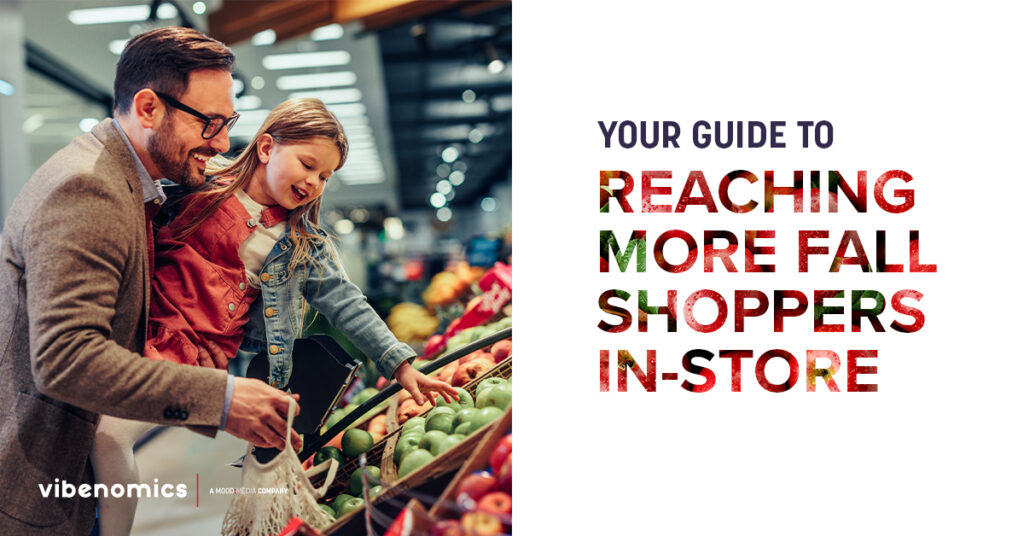
Fall is upon us, bringing a shift in consumer behavior that presents an exciting opportunity for brands and retailers. With the crisp air and vibrant colors come eager shoppers, ready to purchase everything from pumpkin-spiced treats to Halloween decorations. According to surveys recently conducted by Vibenomics and Suzy Market Research on Fall and Halloween shopping behaviors, this season offers unique opportunities for businesses to engage with customers directly where they shop—in-store. Let’s explore the key data points from these surveys and how in-store advertising can help you effectively reach more fall shoppers this season.
Embrace the In-Store Fall Shopping Surge
Shoppers are overwhelmingly planning to do their fall shopping in-store, with 83% indicating this preference. Whether stocking up on seasonal items or Halloween goodies, most consumers will visit grocery stores, dollar/discount stores, home improvement stores, and drugstores. Here’s a breakdown:
With a significant percentage of shoppers heading in-store, your brand can connect with them right where they make purchase decisions. In-store advertising—especially audio and digital signage ads—can catch shoppers’ attention, influence their buying behavior, and boost impulse purchases.
Capitalize on Seasonal Product Popularity
Fall shoppers are searching for specific seasonal items. According to the surveys:
Promoting these items in-store can significantly boost your sales. Shoppers have already indicated their intent to purchase these products, and in-store advertising is your direct line to influence their final choice. For instance, engaging audio ads highlighting the flavors of your seasonally-themed desserts or beverages can tap into their cravings and push them toward an impulse purchase.
Drive Impulse Purchases with Strategic In-Store Promotions
The data shows that in-store promotions are incredibly effective in driving impulse purchases:
This is where in-store audio advertising shines. By creating captivating and timely promotions, you can encourage shoppers to add those extra items to their baskets. For example, audio ads that creatively promote a temporary price reduction (TPR) on Halloween candy or a limited-edition seasonal treat can immediately capture shoppers’ attention and prompt them to buy.
Leverage Key Shopper Motivations: Price, Quality, Variety, and Promotions
Consumers prioritize price, quality, and variety when shopping for fall items. Similarly, price, variety, and promotions/sales are the top considerations during Halloween. Here’s how you can use this to your advantage:
By tailoring your in-store audio ads to focus on these motivating factors, you can better align with what matters most to shoppers and drive higher engagement and conversion rates.
Engage Shoppers Across Multiple Retail Formats
The data indicates that fall and Halloween shoppers are open to more than one type of store. Grocery stores, dollar/discount stores, home improvement stores, and drugstores are all popular destinations.
This diverse shopping behavior presents a fantastic opportunity for in-store advertising to cast a wide net. Use customized in-store audio messages that speak directly to the shoppers in these different environments. For example, a message in a dollar store might focus on the unbeatable price of seasonal snacks, while a home improvement store might highlight limited-time offers on fall yard/lawn care items.
Target the Top Fall Products with Tailored Messaging
Shoppers plan on purchasing various items this fall—from seasonal treats to home decor. Your in-store advertising should highlight these key categories:
Capture Attention During Key Shopping Moments
Key shopping events like Halloween, Thanksgiving, and Black Friday mark the fall season. Align your in-store promotions with these moments to maximize engagement. For example, create memorable audio ads that build excitement for Halloween costumes or candy and shift to Thanksgiving-themed promotions as the season progresses through dynamic programmatic advertising.
Conclusion: Maximize Your Reach with In-Store Advertising
Most shoppers will be in-store this fall, making it the perfect time to ramp up your in-store advertising efforts. You can effectively reach fall shoppers and boost sales throughout the season by strategically utilizing audio ads highlighting seasonal products, promotions, and critical shopper motivations. Don’t miss the opportunity to capture your share of this in-store shopping surge—let your in-store advertising speak directly to the needs and desires of fall shoppers.
Get ready to make the most of this fall shopping season by engaging your audience where it matters most: in the store!
Getting Started with Vibenomics
Vibenomics, a Mood Media Company, is the leading in-store digital provider with an in-store network that reaches over 170 million monthly unique shoppers and 1 billion monthly shopping visits in the United States. Our platform provides a single, all-in-one retail media network, empowering advertisers to deliver an on-premise experience and connect with consumers via display, audio, and experiential channels.
Ready to elevate your retail media strategy with in-store audio? Click here to engage with Vibenomics today.
Sources:
In today’s competitive retail landscape, where 84% of retail sales continue to occur in-store, engaging consumers at the point of purchase is more critical than ever (Emarketer, May 2024). Vibenomics recognizes that in-store advertising gives brands and advertisers a unique opportunity to influence shopper behavior at the moment of purchase decisions.
To better understand this dynamic, Vibenomics conducted a comprehensive survey with Suzy Market Research that gathered insights from 1,070 shoppers between the ages of 18 and 73. These participants, all of whom identified as primary or shared shoppers of their household, provided valuable perspectives on the shopping journey and the impact of in-store advertising on purchase decisions. The findings of this survey offer a deep dive into the power of in-store advertising and its pivotal role in influencing shopper behavior in today’s retail environment.
The Opportunity In-Store Presents
With 92% of grocery store consumers and 86% of drug store consumers shopping in-store, the potential for in-store advertising is vast. Unlike digital ads that can be easily ignored or blocked, in-store advertising engages consumers in the physical aisles, right where they make their purchases. Consumers gravitate toward in-store shopping for several compelling reasons. A significant 69% of shoppers value the immediacy of purchase, ensuring they can walk out with products in hand. Another 50% appreciate the tactile experience of interacting with products, while 49% find comparing products and prices in-store easier. Additionally, 47% enjoy discovering new products they might not have encountered while shopping online.

These consumer preferences highlight a unique advantage for brands and retailers: in-store advertising can directly influence purchase decisions by capitalizing on consumers’ desire for immediacy, tangibility, and discovery. With a captive audience already primed to buy, in-store advertising is a powerful tool that transforms foot traffic into tangible sales growth.
In-Store Advertising Captivates Consumers
The data shows that 37% of shoppers noticed the audio played by Vibenomics in-store, while 30% noticed digital shelf displays/screens. This high level of awareness and attentiveness demonstrates the value of in-store digital advertising for brands and retailers, as it effectively captures consumers’ attention in a busy retail environment.
Further analysis reveals why in-store audio catches shoppers’ attention:
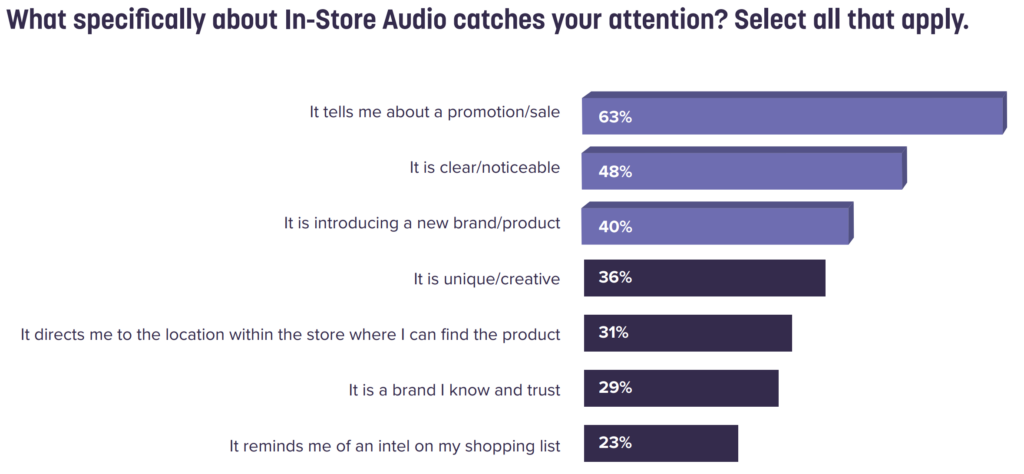
These insights highlight how in-store audio effectively engages consumers and drives them to take action.
In-Store Advertising Influences Action
Moreover, the data indicates that in-store advertising prompts action among shoppers. After hearing the ad, 37% of shoppers located the advertised product in the store, and 35% purchased the advertised product or a similar product. This data highlights the persuasive power of in-store digital advertising to drive sales, grow share of voice, and defend against competitors.
In-Store Advertising Impacts Omnichannel Activity
The impact of in-store advertising extends beyond the physical store and influences activity within other channels. After hearing the audio ads:
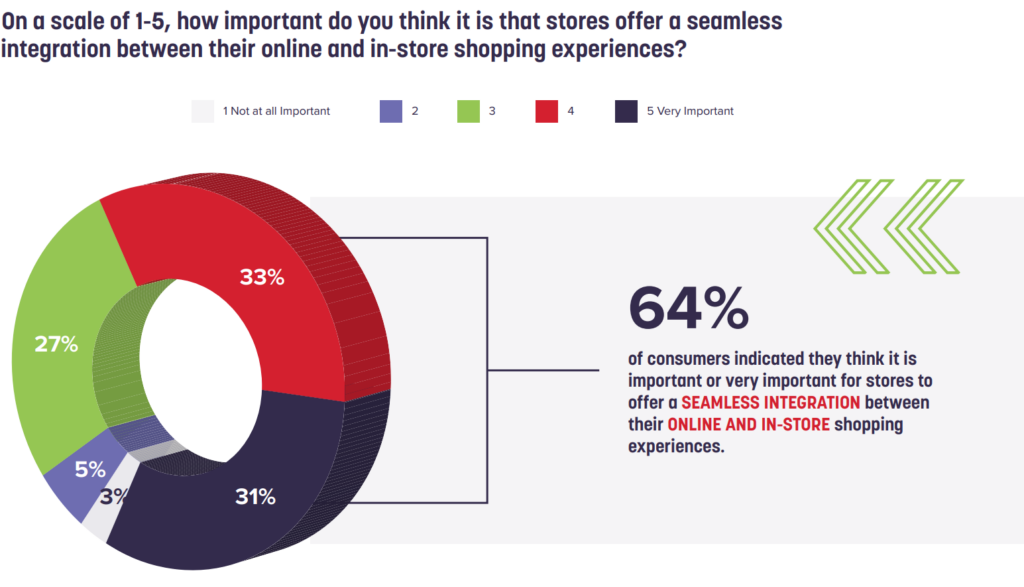
Additionally, 64% of consumers indicated that stores must seamlessly integrate their online and in-store shopping experiences. This data demonstrates the importance of a cohesive omnichannel marketing approach, where in-store advertising is crucial in driving both onsite and offsite engagement.
In-Store Advertising Is Informative, Engaging, and Persuasive
Identifying what matters to in-store shoppers enables brands to design impactful creative that resonates with shoppers and influences purchase decisions. Vibenomics Creative Studios creates quality and impactful audio ads that bring brands to life as shoppers browse the aisles. By incorporating catchy jingles, humorous elements, and unique sound effects, our team can help brands create dynamic campaigns that resonate with consumers.
57% of shoppers indicated that in-store audio advertising is informative, while:

These findings underscore the effectiveness of in-store advertising in creating a lasting impression on consumers. By leveraging the power of sensory engagement, retailers can significantly enhance the shopping experience in a meaningful way for consumers.
Conclusion
The data collected by Vibenomics demonstrates the effectiveness of in-store advertising, particularly in-store audio, in engaging consumers and driving sales. With a high level of noticeability, the ability to influence action, impact omnichannel activity, and inform, engage, and persuade shoppers, in-store digital advertising emerges as a powerful tool for brands and retailers looking to enhance their marketing efforts. By leveraging the unique advantages of in-store advertising, brands can take their advertising strategies to the next level with Vibenomics.
About Suzy Market Research
Suzy is a cutting-edge, real-time consumer insights platform trusted by over 400 enterprises across 22 industries. Suzy integrates quantitative and qualitative data with high-quality audiences into a single connected research cloud, providing businesses with the insights they need to make informed decisions quickly and efficiently.
Getting Started with Vibenomics
Vibenomics, a Mood Media Company, is the leading in-store digital provider with an in-store network that reaches over 170 million monthly unique shoppers and 1 billion monthly shopping visits in the United States. Our platform provides a single, all-in-one retail media network, empowering advertisers to deliver an on-premise experience and connect with consumers via display, audio, and experiential channels.
Ready to elevate your retail media strategy with in-store audio? Click here to engage with Vibenomics today.
Source: Vibenomics In-Store Advertising Suzy Market Research Report, July 2024
Next Page »